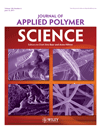Improved thermal stability and mechanical properties of poly(propylene carbonate) by reactive blending with maleic anhydride
Abstract
To extend the application of a carbon dioxide sourced environmental friendly polymer: poly (propylene carbonate) (PPC), a small amount of maleic anhydride (MA) was melt blended to end-cap with PPC to improve its thermal stability and mechanical properties. Thermal and mechanical properties of end-capped PPC were investigated by TGA, GPC, mechanical test, and DMA. TGA and titration results demonstrate that PPC can be easily end-capped with MA through simple melt blending. TGA results show that the thermal degradation temperature of PPC could be improved by around 140°C by adding MA. GPC measurement indicates that the molecular weight of PPC can be maintained after blending with MA, where pure PPC experiences a dramatic degradation in molecular weight during melt process. More importantly, the tensile strength of PPC after blending with MA was found to be nearly eight times higher than that of pure PPC. It has approached the mechanical properties of polyolefin polymers, indicating the possibility of replacing polyolefin polymers with PPC for low temperature applications. The method described here could be used to extend the applications of PPC and fight against the well known global warming problem. © 2011 Wiley Periodicals, Inc. J Appl Polym Sci, 2011




